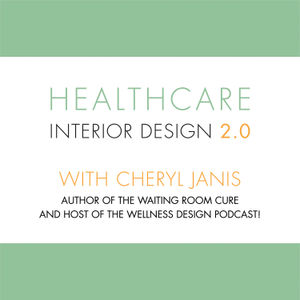
Healthcare Interior Design 2.0
Porcelanosa
Episode 62, Debra Levin, Hon. FASID, EDAC, President and Chief Executive Officer, The Center for Health Design

Episode 62, Debra Levin, Hon. FASID, EDAC, President and Chief Executive Officer, The Center for Health Design
Description
"The saying is if you want to go fast, go alone, but if you want to go far, go together. And together is the way you create change.” –Debra Levin on The Healthcare Interior Design 2.0
On today’s episode, Cheryl interviews Debra Levin, Hon FASID, EDAC, President and Chief Executive Officer at The Center for Health Design. Lean in and listen to this exciting conversation about how The Center is adapting and expanding its initiatives to facilitate collaboration and knowledge-sharing between the healthcare, design, and product manufacturing sectors. A key focus is how The Center is building bridges across these communities through multidisciplinary events, research partnerships, and new specialized network groups like Pediatric Environment Network (PEN), Resilient Aging Environments Network (RAEN), and Behavioral Mental Health Environment Network. Learn more about The Center’s member resources like The Knowledge Repository and how it has been driving innovation and improving healthcare environments in the post-COVID era.
Learn more about The Center for Health Design by visiting: https://www.healthdesign.org/.
Reach out to Debra Levin directly by sending her an email to: [email protected].
In Cheryl’s conversation with Debra Levin they discuss:
-
What’s new and changing at The Center that is influencing the healthcare design industry?
-
Learn about The Center’s new "environment networks" or membership groups that have been created around specific healthcare settings, like the Pediatric Environment Network (PEN), Resilient Aging Environments Network (RAIN) , and the Behavioral Mental Health Environment Network.
-
Learn about the small groups fostering collaboration across sectors and how this aligns with The Center’s goal of facilitating multidisciplinary conversations.
-
What is the PDC Summit and how has The Center become a strategic education partner with the PDC, hosted by ASHE, for the first time in 2024?
-
The Center’s strategic planning after COVID to engage a global audience more effectively.
-
The Center’s latest focus on building bridges between healthcare, design, and product manufacturing communities.
-
Learn about the new search functionality on The Center’s website, added to improve accessibility.
-
What are the emerging trends in healthcare?
-
How you can get involved with The Center through things like affiliate memberships including free memberships for students.
Shout Outs:
8:00 - Debra mentions EPIC, "We included people from broader, diverse areas, like a practicing physician who also does design research, somebody from EPIC, a hospital CEO who also has a nurse background.”
11:37 - Debra shares information about The American Hospital Association (AHA) and ASHE (the engineering group of AHA) “It is a program that was spearheaded by ASHE, which is the engineering group of the American Hospital Association."
21:09 - Debra discusses the AAHID (American Academy of Healthcare Interior Designers) and the FGI (Facility Guidelines Institute), and the NIHD (Nursing Institute for Healthcare Design Professionals)
The world is changing quickly. The Center for Health Design is committed to providing the healthcare design and senior living design industries with the latest research, best practices and innovations. The Center can help you solve today’s biggest healthcare challenges and make a difference in care, safety, medical outcomes, and the bottom line. Find out more at healthdesign.org.
Additional support for this podcast comes from our industry partners:
-
The American Academy of Healthcare Interior Designers
-
The Nursing Institute for Healthcare Design
Learn more about how to become a Certified Healthcare Interior Designer® by visiting the American Academy of Healthcare Interior Designers at: https://aahid.org/.
Connect to a community interested in supporting clinician involvement in design and construction of the built environment by visiting The Nursing Institute for Healthcare Design at https://www.nursingihd.com/
FEATURED PRODUCTThe prevention of nosocomial infections is of paramount importance. Did you know that bathrooms and showers – particularly in shared spaces – are a veritable breeding ground for pathogen, some of which we see in the form of mold and the build-up of toxic bio films on surfaces.
Body fats and soap scums provide a rich food sauce for micro-organisms such as airborne bacteria Serratia Marcescens, which thrive in humid conditions.
We know that people with weakened immune systems are so much more vulnerable to the illnesses associated with infection and let’s face it, none of us go into the shower with an expectation that we might get sick.
So how do we keep those shower walls clean? Well let’s think big – BIG TILES.
Porcelanosa have developed XXL Hygienic Ceramic Tiles that are 5 feet long - which means just one piece fits the wall of a shower or tub surround. XTONE Porcelain slabs are 10 feet high which means a floor to ceiling surface with no joints.
Why does this matter? Well hygienic glaze will not harbor pathogen and surface impurities are easily removed to prevent build up – it is reassuring to know the evidence - INTERNATONAL STANDARDS Test ISO 10545 - Resistance to Stains - has determined these surfaces can be easily cleaned and the most difficult contaminants washed away, greatly reducing the need for aggressive chemicals.
Think about this…When we unload our dishwasher our ceramic tableware is sparkling clean, sanitized and fresh to use - again and again. The principle is the same with large ceramic walls - So, when planning the shower surrounds for your facilities please reach out to Porcelanosa. The designer in you will love the incredible options and your specification will deliver the longest & best lifecycle value bar none.